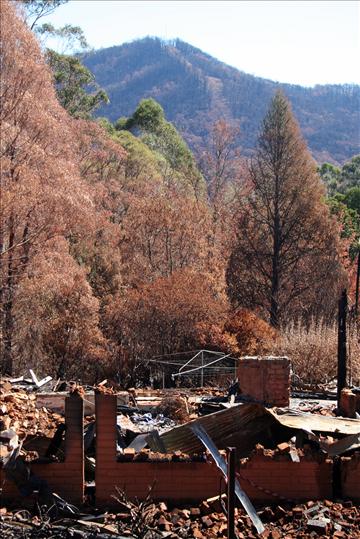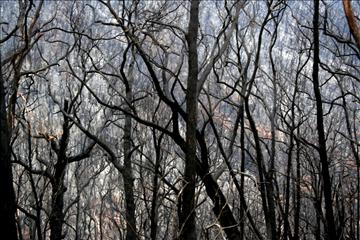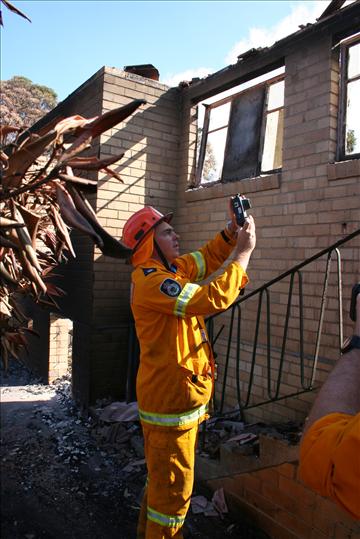Black Saturday - Research Taskforce
Created date
Wednesday, August 25, 2010 - 7:12amThe Victorian bushfires of 7 February 2009 resulted in major loss of life, property, and other assets. The questions and issues that quickly emerged will be the subject of debate, in Australia and internationally, for years to come.
 In developing directions for the future, the Victorian fire and land management agencies believed it was vital that decisions were based on solid evidence of what happened and why. To do this thoroughly, a major research effort was required to establish an authoritative and independent set of data for the Australian and international fire community.
In developing directions for the future, the Victorian fire and land management agencies believed it was vital that decisions were based on solid evidence of what happened and why. To do this thoroughly, a major research effort was required to establish an authoritative and independent set of data for the Australian and international fire community.
Less than 48 hours after the devastating bushfires, the Bushfire CRC was asked to establish a Research Taskforce to undertake the biggest data collection and analysis program ever undertaken in the aftermath of a bushfire disaster in Australia, and quite probably anywhere.
Almost every day over a period of nearly two and half months, the Bushfire CRC placed teams of up to 50 researchers from across Australia, New Zealand and the United States in the field. This amounted to more than 2000 staff days of extensive data collection and analysis, working in the aftermath of the disaster alongside fire fighters, police, community workers and residents across the fire affected areas.
The Taskforce looked at more than 1300 homes, interviewed more than 600 residents, and took over 21,000 photographs.
This was not the only data collected in this period and much of this supplementary data will have information that could add further depth to the analysis. Specifically, this Taskforce has not considered observational logs of fire service personnel or material collected by other agencies (most notably police fatality information and the Rapid Impact Assessment facilitated by the Office of the Emergency Services Commissioner on behalf of the response agencies) or the detailed (post-event) weather reports of by the Bureau of Meteorology.
There is also a wealth of information available on various web pages, both on media and public sites, that provide first-hand reports and visual images (video and photographs) of fire behaviour and impacts across a variety of locations that can be interrogated in future work.
The imperative for the Research Taskforce was to collect time-critical data that would rapidly degrade due to the weather, site clearance or other types of interference.
This data addresses a range of questions relating to fire behaviour, human behaviour, and house survival or destruction.
In broad terms, the research focussed on:
- the fire behaviour observations across the major Victorian fires
- the human behavioural factors that impacted upon the patterns of property or life loss or saves during these fires
- the building and land-use planning factors in select areas that contributed to the pattern of property or life loss (or saves) during these fires
- the way in which these factors worked collectively to impact on the pattern of loss of life and property.
 All aspects of the work considered the question: Was the impact of the fires of 7 February 2009 consistent with established knowledge or was this a result of previously unidentified behaviours or factors?
All aspects of the work considered the question: Was the impact of the fires of 7 February 2009 consistent with established knowledge or was this a result of previously unidentified behaviours or factors?
An interim report was submitted to the 2009 the Victorian Agencies and subsequently the Victorian Bushfires Royal Commission in June. This report of around 700 pages outlines the data collected across various areas that were burnt, as well as drawing some preliminary conclusions and findings from this data.
Some of these preliminary findings related to specific fires, others were more general across all the fires. Some of the more general findings include:
Fire behaviour
- Spotting ahead of the main fire front played a significant part in the forward rate of spread of all the fires. Evidence was found of some spotting reaching more than 30kms from the main fire.
- The current fire behaviour meters under-predicted the forward rate of fire spread seen on the day.
- The 1939 Black Friday fires provide the closest set of conditions for comparison with 7 February 2009. (Those fires burnt almost 2 million hectares with the loss of 71 lives.
Human Behaviour
Planning and preparedness:
-
Many residents were not prepared for the severity of the 7 February bushfires.
- A considerable amount of last-minute planning and preparation took place on the day.
- There are many examples of ‘weak links’ in people’s planning and preparation that affected their ability to implement their fire plan.
Information and Warnings:
- Fire agencies and local councils had been only modestly successful in informing members of at-risk communities about effective preparation and planning for bushfires.
- Predictions in the preceding week were that Saturday 7 February was to be a day of unprecedented fire danger. There was only modest awareness of the implications of this within the community.
Intentions and actions:
- A significant number of residents intended to wait and see what the bushfires were like before deciding whether to stay or go. These residents wanted to stay and defend their homes and properties, but were not fully committed or confident in their ability to do so in all conditions.
- Less than half of the households in the initial sample reported that a household member stayed to defend. Some of those who intended to stay and defend left because of the severe conditions.
- More than half of the households in the initial sample reported that a household member left because of the fires. There appear to have been many late evacuations.
- A very small number of interviewees took no defensive action and sheltered throughout the fire.
Emerging issues and themes:
- Many community members regard public buildings, ovals and emergency services facilities as safe places of refuge during a bushfire.
- Some of those who stayed to defend their homes and properties reported a range of factors that influenced their capacity to defend their homes. These included heat exhaustion, dehydration, breathing difficulties, and eye irritation. A range of pre-existing medical conditions, such as asthma and arthritis, also inhibited some people’s capacities to defend their homes.
- Anecdotal evidence suggests that many of those who sheltered passively inside their homes may have done so in bathrooms.
Building and Planning
- Active defence of structures has a major influence on house survival.
- Building quality, detail and possibly house age appear to be factors in determining the likelihood of house loss.
- Brick houses performed significantly better than mud brick and light-weight construction clad with timber or cellulose cement sheet.
- The potential for wind damage of structures should be a key factor in future building standards consideration for bushfire-prone areas.
- House loss has occurred at distances greater than 380m from continuous bush.
- < Metal and concrete water tanks are more effective in maintaining an effective water supply for house defence than polyethylene or fibreglass tanks.
- Careful design of piping and pump location are required to maximise the chance of maintaining an effective water supply throughout to fire event.
- Mains water pressure and mains electricity cannot be relied upon during a fire event.
- Vegetation overhanging or immediately adjacent to a house is a key factor in house loss.
 It was due to the foresight of the leaders of the Victorian agencies in initiating this work that have ensured the learnings from this event were captured in the hope that this will help us all better understand such events into the future.
It was due to the foresight of the leaders of the Victorian agencies in initiating this work that have ensured the learnings from this event were captured in the hope that this will help us all better understand such events into the future.
The next stage is to undertake a thorough scientific analysis of the data. This requires agreement on the research questions for which knowledge is sought and on stakeholders who wish to be involved.
The Bushfire CRC is actively encouraging international collaborations to increase the research effort and to share the new knowledge globally.
(This article first appeared in the Spring 2009 issue of Fire Australia magazine)



